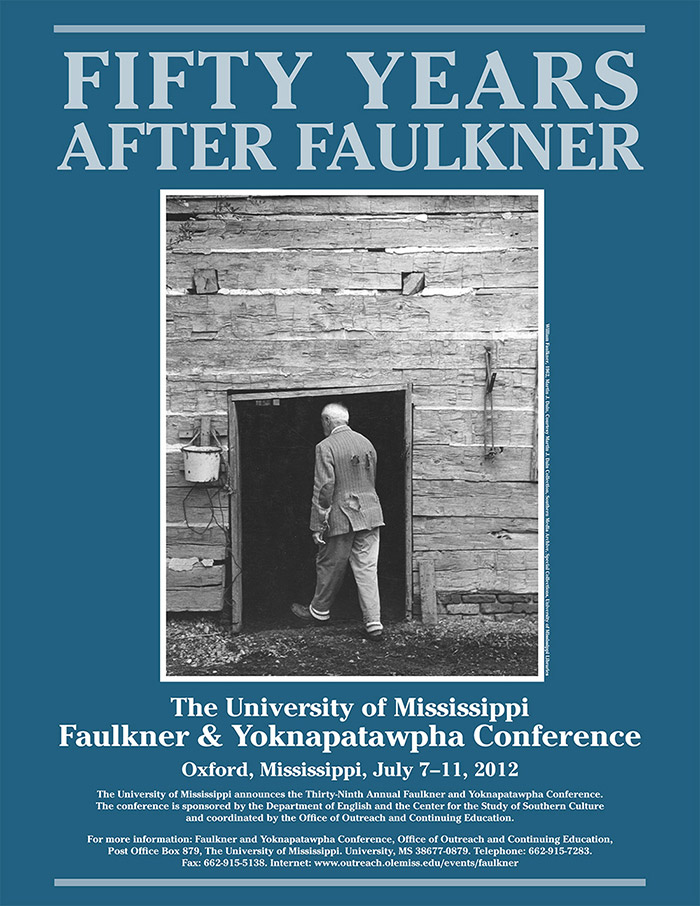
Panel. Faulkner and the Visual
Location
Nutt Auditorium
Start Date
11-7-2012 2:00 PM
Description
- Seeing in the Dark Houses: History and Obscurity in Light in August and Absalom, Absalom! / Peter Lurie, University of Richmond
My paper pursues the figuration of darkness in arguably Faulkner’s two most historical novels. Responding to theories of history that rely on notions of discovery or revelation, I consider ways in which Faulkner texts refuse to posit clear representations of historical content, moments that flaunt the incapacity of characters or readers to “know” (or even see) the objects of the books’ narration. In tracing several aporias within Faulkner’s most notably challenging novels, both of which were originally titled Dark House, I demonstrate that such difficulty relates directly to these works’ historicity and their always trenchant treatment of race. The result is a more vital, while also less visual historicity born out by indirection, obscurity, and Faulkner’ abstruse formal workings. - Drawing Death: Death and Circuits in the Early Drawings of William Faulkner / Candace Waid, University of California at Santa Barbara
At the age of 13, Faulkner sent his mother a birthday present that included two drawings: a formal drawing in ink and, on the other side, a sketch in pencil. This talk offers the first reading of these drawings, identifying them as an early key to Faulkner's development and his narratively-driven, visually-obsessed mind. After analyzing how these drawings provide a profound and early meditation on death that directly anticipates The Sound and the Fury, the paper focuses on the complex visual narrative in Faulkner's hand-drawn and hand-illustrated Marionettes (1920) to reveal the imbricated circuit of consummation and death in the drawings that Faulkner made for the original version. - Pictures and Words in Faulkner’s Early Graphic Work / Randall S. Wilhelm, Clemson University
In analyzing Faulkner’s early graphic work, it is important to note that he did not first study the visual arts, then forsake them for literature: he worked in both modes simultaneously, often combining the two media in the same artistic production. This is a critical distinction since it stresses Faulkner’s multiple creativity and the importance of viewing his work as bound in a dialectical relationship between visual and verbal modes of representation. I will examine the word-image interaction that informs Faulkner’s early cartoons and illustrations which incorporate words into the visual field through design, calligraphy, and captions, as well as his “visual grammar” that employs some of his most fundamental stylistic tendencies such as the tableau, the focal garment, the inset story, and the boxed space.
Relational Format
Conference proceeding
Recommended Citation
Lurie, Peter; Waid, Candace; and Wilhelm, Randall S., "Panel. Faulkner and the Visual" (2012). Faulkner and Yoknapatawpha Conference. 69.
https://egrove.olemiss.edu/fy/2012/schedule/69
COinS
Jul 11th, 2:00 PM
Panel. Faulkner and the Visual
Nutt Auditorium
- Seeing in the Dark Houses: History and Obscurity in Light in August and Absalom, Absalom! / Peter Lurie, University of Richmond
My paper pursues the figuration of darkness in arguably Faulkner’s two most historical novels. Responding to theories of history that rely on notions of discovery or revelation, I consider ways in which Faulkner texts refuse to posit clear representations of historical content, moments that flaunt the incapacity of characters or readers to “know” (or even see) the objects of the books’ narration. In tracing several aporias within Faulkner’s most notably challenging novels, both of which were originally titled Dark House, I demonstrate that such difficulty relates directly to these works’ historicity and their always trenchant treatment of race. The result is a more vital, while also less visual historicity born out by indirection, obscurity, and Faulkner’ abstruse formal workings. - Drawing Death: Death and Circuits in the Early Drawings of William Faulkner / Candace Waid, University of California at Santa Barbara
At the age of 13, Faulkner sent his mother a birthday present that included two drawings: a formal drawing in ink and, on the other side, a sketch in pencil. This talk offers the first reading of these drawings, identifying them as an early key to Faulkner's development and his narratively-driven, visually-obsessed mind. After analyzing how these drawings provide a profound and early meditation on death that directly anticipates The Sound and the Fury, the paper focuses on the complex visual narrative in Faulkner's hand-drawn and hand-illustrated Marionettes (1920) to reveal the imbricated circuit of consummation and death in the drawings that Faulkner made for the original version. - Pictures and Words in Faulkner’s Early Graphic Work / Randall S. Wilhelm, Clemson University
In analyzing Faulkner’s early graphic work, it is important to note that he did not first study the visual arts, then forsake them for literature: he worked in both modes simultaneously, often combining the two media in the same artistic production. This is a critical distinction since it stresses Faulkner’s multiple creativity and the importance of viewing his work as bound in a dialectical relationship between visual and verbal modes of representation. I will examine the word-image interaction that informs Faulkner’s early cartoons and illustrations which incorporate words into the visual field through design, calligraphy, and captions, as well as his “visual grammar” that employs some of his most fundamental stylistic tendencies such as the tableau, the focal garment, the inset story, and the boxed space.

